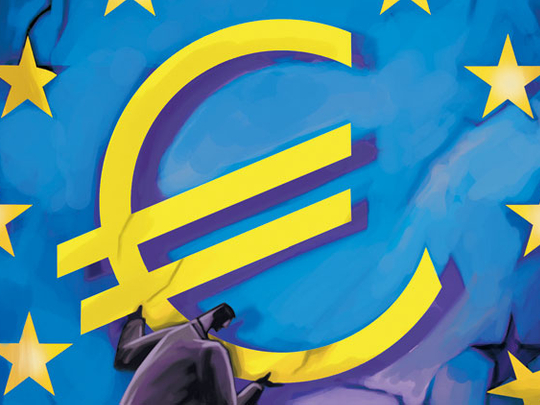
It was said of one 19th century British politician that he never missed a chance to let slip an opportunity.
Will the euro summit of 2011 be remembered as "the day European leaders faced the crisis down" — or will it be viewed, in retrospect, as the turning point at which history failed to turn?
Up against almost impossible constraints — the contradictory wishes of 16 euro members, German public opinion and the European treaty itself — it is to German Chancellor Angela Merkel and French President Nicolas Sarkozy's credit that they brokered a deal which kept Greece liquid and calmed European markets down.
But these constraints — which mean there can be no bailout, no default, no devaluation and no more money — exist and seem unchallengeable because Europe has not yet faced up to the scale of its crisis. All European leaders can agree on is that they face a fiscal crisis hitting their periphery. Yet the European crisis is not one-dimensional but three-dimensional: not just a fiscal crisis but a banking crisis — one of massive unfunded bank liabilities — and a crisis of low growth, itself the result of the euro's inbuilt impediments to recovery. Together and in lethal combination they threaten a tragic roll call year after year of millions of European citizens unnecessarily condemned to joblessness.
New Deal
At moments of crisis, statesmen and stateswomen have to lead markets and display irresistible resolve. The best example is when, pushing uphill against the constraints of the day, Roosevelt's New Deal of the 1930s turned orthodoxy on its head and pursued stimulus instead of austerity. In April 2009 at the London G20 Summit, the world had to underpin its economy by the boldest and most dramatic of measures.
At its moment of truth last week, Europe needed to break from its past constraints and agree to historic changes — the costly restructuring of banks, the coordination of monetary and fiscal policies, and reforms to the euro itself to remove structural barriers to growth. Specifically, the Brussels summit needed to accept the inevitability of fiscal transfers, prepare for a precautionary facility for Italy and Spain, and, at a minimum, expand the European stability fund, underpinning it with a backstop facility far bigger than its current size. Yet not one of these items even reached the agenda.
Action, however, that is deferred at one point of crisis will mean even more radical action is required at the next juncture. What might have satisfied markets last month — a Brady-style bailout for Greece — will next time not be sufficient to end Europe's economic agony. And I fear that in a few months' time we will need a far bigger backstop — perhaps up to €2 trillion (Dh10.6 trillion) to cover the future funding needs of Italy, Ireland, Greece, Portugal, Spain and Belgium. On top of this, bank restructuring may cost as much as €200 billion in new capital, perhaps even €300 billion, requiring an overall package — partly euro-member-state-financed, partly IMF-financed — equivalent to a quarter of Eurozone GDP. Then we will also have to create a European debt facility (perhaps for up to 60 per cent of national GDPs) and, as a sequel to that, greater fiscal and monetary coordination — which will, in turn, mean fiscal transfers on the model of, if nothing yet akin to the scale of, the USA.
But, even if all these stabilisation measures are agreed upon, Europe's growth will remain anaemic, and, far from falling according to plan, deficits and unemployment may remain too high. So there is a final inescapable dimension, what I call the "global Europe plan" — a determination that Europe stops looking inwards and looks outwards to export markets in the eight fastest-growing economies (India, China, Brazil, Russia, Indonesia, Turkey, South Korea and Mexico) that will generate most of the world's new growth. Today only 7.5 per cent of Europe's exports go to these fast-rising economies that will create 70 per cent of the world's growth.
Sustained growth
The key to achieving sustained growth is not only a repositioning of Europe from consumption-led growth to export-led growth, but radical capital product and labour market reforms to equip the euro area for global competition — and a G20 agreement with America and Asia to coordinate a higher path for global growth.
None of this was discussed in any detail in Brussels. Yet without that agenda for growth, even the most painful austerity is unlikely to prevent contagion to come.
European leaders, who assumed for ten years that the stability pact was all they needed to cope with a crisis, will find they also have to face up to unprecedented constitutional change. One of the reasons I opposed Britain joining the euro was that it had no crisis-prevention or crisis-resolution mechanism and no line of accountability when things went wrong. Today we find Europe's political leaders blocked from expanding the already fragile European Financial Stability Facility because of a voting structure that requires unanimity; still unsure who is responsible in a crisis not least because of their ambiguous relationship with the independent European Central Bank; and even now unable to contemplate the constitutional issues raised by fiscal integration.
But every time the big questions are avoided, and every time the outcome is a patchwork compromise, the next crisis gets ever closer and threatens to be more dangerous. That approach can no longer suffice. From now onwards, no one can assume that Europe's past strength as a continent is enough to prevent the most difficult of future outcomes.
— Project Syndicate
The former British prime minister gives his thoughts on what Europe's next move should be












